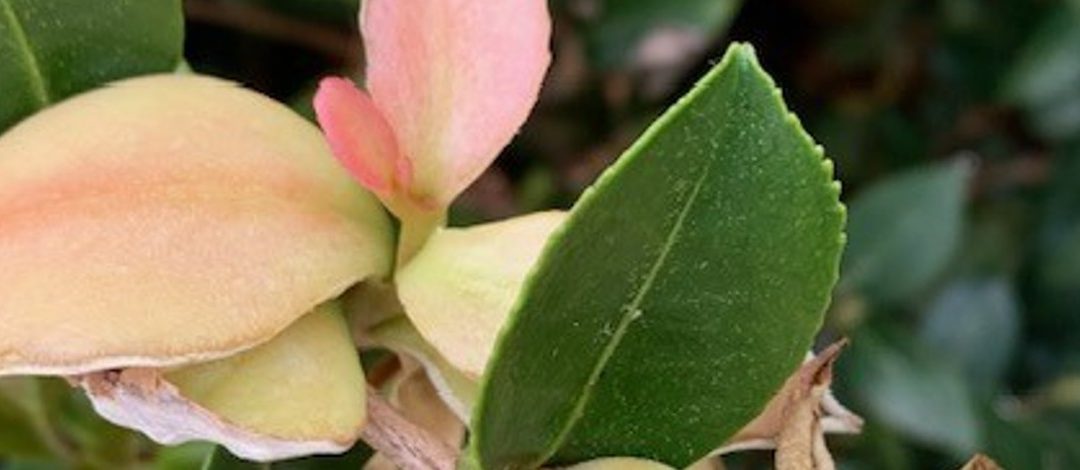
by Larry Williams | May 2, 2024
Q. Some of the leaves on my azalea and/or camellia are swollen and light green. What caused this?
A. This is caused by a fungus that has been relatively common this spring.
The fungus Exobasidium vaccinii causes leaves and flowers to become swollen or thickened, curled and waxy in appearance. This fungus causes leaves, and in some cases flower petals, to enlarge abnormally and is commonly referred to as azalea or camellia leaf and flower gall.
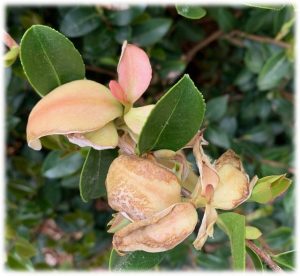
Exobasidium leaf gall on camellia. Credit: Larry Williams
Symptoms vary somewhat based on the host plant. In addition to azalea and sasanqua camellia, it can occur on blueberry, as well. Infected blueberry leaves turn an unusual bright red in spring with almost no swelling of tissue. With azaleas and camellias, leaves become large and distorted and eventually a white powder covers the galls. The white growth consists of spores, which is how the fungus reproduces. Galls ultimately turn brown and harden. Not every leaf will be infected. It’s more common for the plant’s lower leaves to be the most heavily infected but under humid conditions and in shaded locations galls may form on leaves throughout the plant canopy.
The disease relies on airborne spores produced in the whitish mold on the surface of galls in late spring to early summer to reproduce. The galls then form the following spring. It’s important to remove and dispose of infected leaves before they turn white with spores.
Once you see evidence of infected leaves, it’s too late for chemical control. Besides, there currently is no effective or practical fungicide to control this disease in the home landscape. But you can reduce the amount of infection on your plants the following year by pruning infected leaves and throwing them away before spores are produced. After removing infected leaves with galls, never leave them on the ground around the plants.
It’s best to bury, burn or place the infected leaves in a plastic bag and throw them away. This disease is more severe during a cool, wet spring. It’s advisable to not add to the problem by artificially providing the “wet weather” the spores need by frequently using an overhead sprinkler and keeping the foliage wet in the spring during disease development. This is exactly what this and many other plant diseases need – wet conditions. Yet another reason to water during early morning and on an as needed basis, versus allowing an irrigation system to frequently run when there is already adequate moisture from rain.
In the home landscape, the fungus does not cause any long-term problems for the plant. It just makes the plant’s leaves look ugly. The infected leaves will usually fall prematurely.

by Joshua Criss | May 2, 2024
Overview of Daylilies
Spring has begun, and the flowers are making their debut en masse. The daylily is an exceptionally versatile plant that grows in various colors, shapes, and habitats (Hemerocallis spp.). This plant garners its name from a combination of Greek terms meaning “beauty for a day,” given the tapestry a mass planting provides, they live up to that name. These plants tend to bloom repeatedly for 4-7 weeks, though each individual flower only lasts one day. The time of year flowering begins varies by cultivar, but typically, they may be seen beginning in March, with later bloomers starting around mid-May. Add to their beauty that they are also edible, and you have a plant that can’t be beaten.
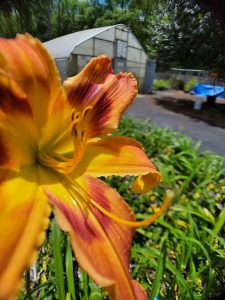
UF/IFAS Photo: J. Criss
These perennials are widely available as bare-root or potted plants. Both may be planted in Florida year-round, but planning in spring or autumn will increase success. Inspect roots before you plant them, removing any that are circling or damaged. Plant with the crown at ground level, much like a tree, and keep the soil moist until the plant is established. Though drought tolerant with deep roots, you’ll still want to apply mulch to retain moisture. Fertilizers may be added in spring, summer, and fall based on soil testing. Scouting this planting is important, but insects rarely cause lasting damage. They may be propagated vegetatively or via seed. Vegetative propagation will become important as these plants fill in spaces over the years and will need to be thinned.
Uses in the Landscape
Thanks to the hybridization efforts of growers worldwide, daylilies are available in every spectrum of color and a variety of flower shapes. Daylilies are clumping plants with grasslike foliage and flowers on a scape that may reach up to 36 inches tall. They can be striking when planted in groups of 10, included in a mixed border, or used to highlight a specific area of your gardens. Because they are so varied, it is important to carefully consider the design elements of your landscape and the growing conditions of your landscape when selecting varieties. All cultivars will require some sun, so avoid heavily shaded areas.

UF/IFAS Photo: J. Criss
A Note on Color
Your biggest concern when considering daylilies in the garden will be color. When it comes to landscape design, color integration has three main theories. The first revolves around monochromatic flowering. Simply put, except for the green foliage, all flowers in this type of garden will be one color. Certainly, daylilies fall into this category, which are often yellow and may be quite striking. The second theory on color in your garden spaces is an analogous scheme in which 3-5 colors on the color wheel are utilized to create continual flow. In this case, find daylilies with red flowers and pair them with violet or yellow flowers. The final theory on color use in gardens is a complementary scheme. In this instance, colors on opposite sides of the color wheel are utilized. The contrast created by this method can create a striking difference that draws the eye to a specific point. Keep in mind that these are all theories. Ultimately, it is your landscape, and you should use those flower colors which satisfy your sensibilities.

UF/IFAS: Gail Hansen
Daylilies are a wonderful plant for your landscape. Easy to grow with great variety, few others can compete with them. For more information, see this Ask IFAS document. As always, please contact your local extension agent for additional information on this and any topic regarding your gardens and more.

by Matt Lollar | May 2, 2024
They’ve mostly all moved away for now, but every winter and early spring the office gets questions about tiny beetles in homes. These beetles are small with spotty color patterns. The answer is carpet beetles. Carpet may be in their name, but it may not be their favorite spot. Carpet beetles feed on a lot of the same things as clothes moths such as wool, felt, and fur because these materials contain keratin. And their feeding damage is often mistaken for that of clothes moths.
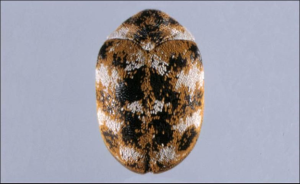
Varied carpet beetle adult. Photo Credit: Lyle J. Buss, University of Florida/IFAS
Adult carpet beetles are between 1/16 to 1/8-inch in length. They are oval-shaped and range in color from black to various patterns of white, brown, yellow, and orange. The majority of samples we see are black and white mottled. The adults are often found on windowsills and window stools in the springtime. The larvae conduct all the damage to fabrics and other materials, while the adults stick to feeding on flower pollen. The evidence of feeding can be seen by threadbare spots and irregular holes. Blankets and clothes in storage and carpeted areas under furniture are preferred because they are undisturbed.
As with most insect pests, prevention is the best control for carpet beetles. In addition to feeding on fabrics and material, larvae feed on dust, lint, and animal hair. Frequent cleaning of floors and vacuuming of rugs and carpets eliminates most of the food supply. Stored blankets, clothes, and rugs should be periodically cleaned, brushed, and or sunned. Moth balls can be used at labeled rates but should not be the sole means of control.
For more information on carpet beetles and more detailed prevention and control tactics, please go the University of Florida/IFAS Publication: “Pests in and around the Souther Lawn – Carpet Beetles”.
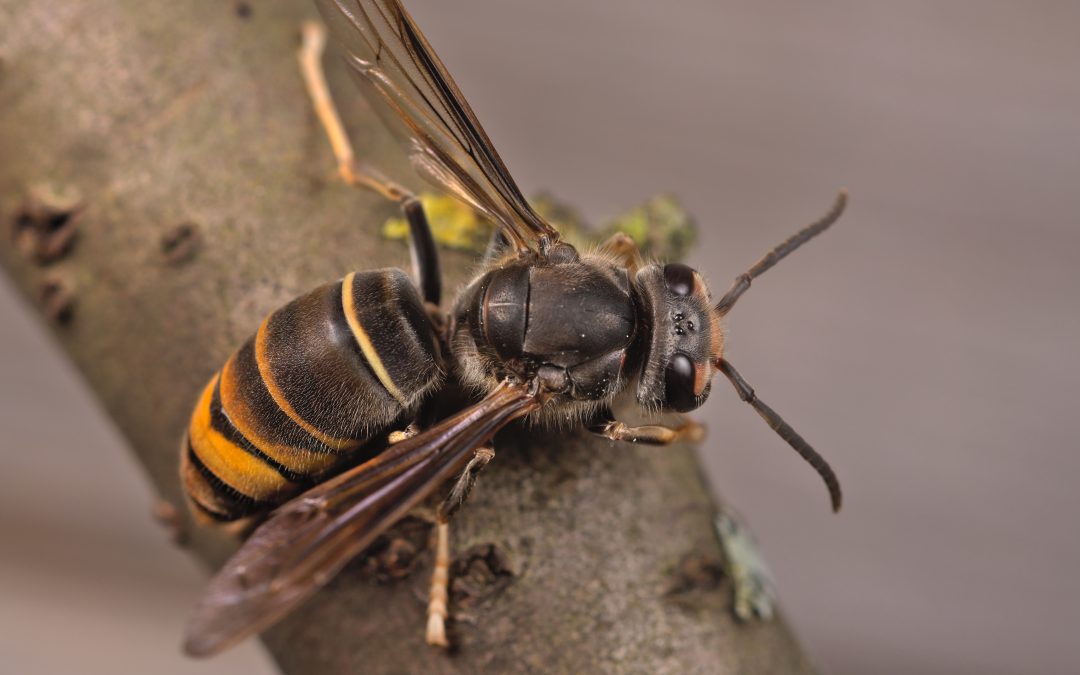
by Molly Jameson | Apr 25, 2024
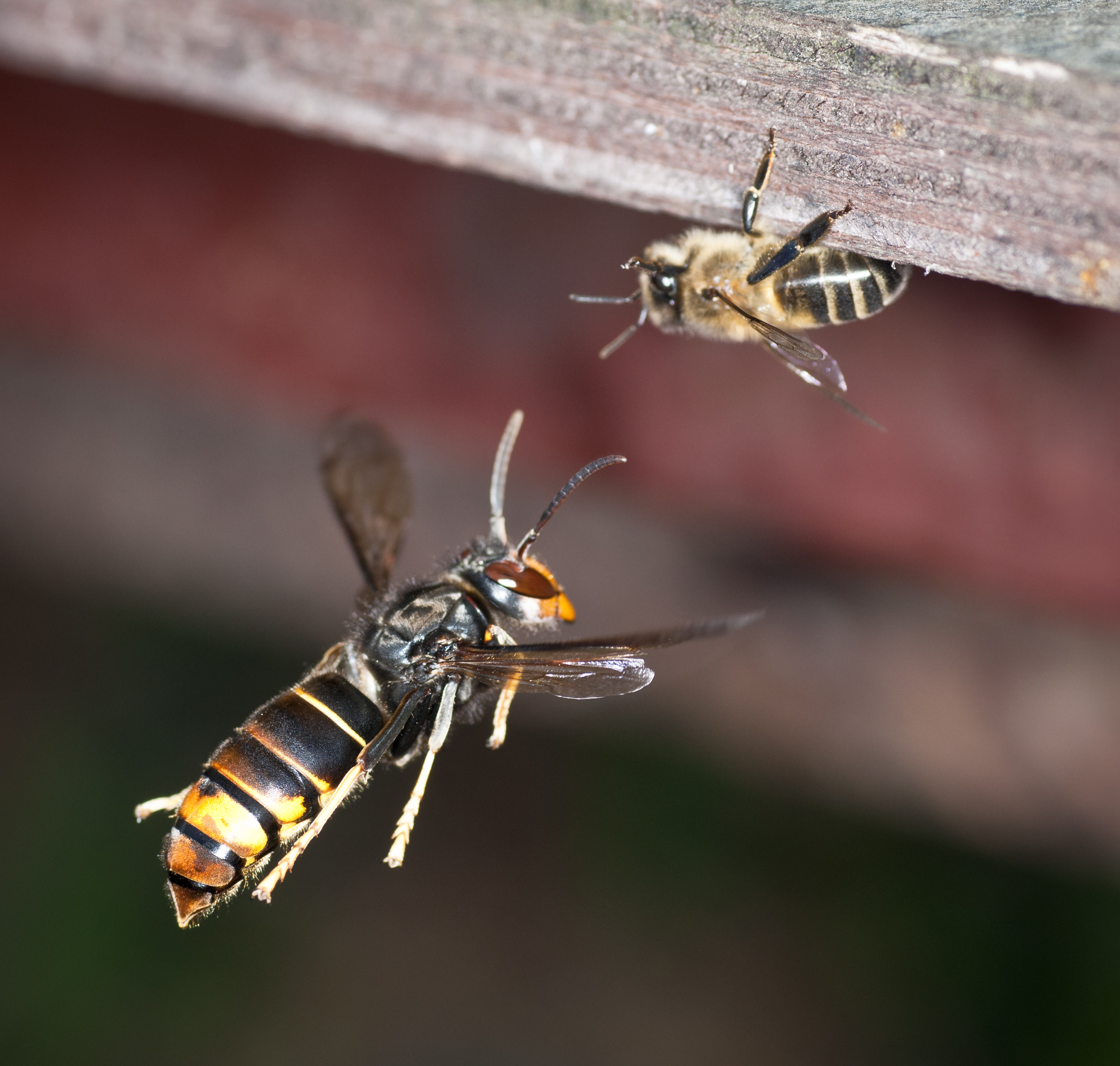
Florida beekeepers are on high alert as the invasive Vespa velutina hornet poses a threat to honey bees, prompting vigilant monitoring to safeguard against potential impacts. Photo by Danel Solabarrieta, licensed under CC BY-SA 2.0.
A concerning discovery has emerged in Savannah, Georgia, regarding the yellow-legged hornet, commonly known as the “murder hornet’s cousin.” Officially identified as Vespa velutina by the Georgia Department of Agriculture in August 2023, it was first encountered by a beekeeper in the area.
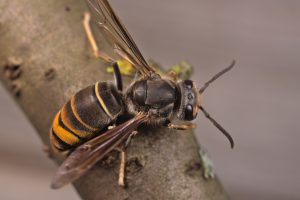
The size of a nickel, Vespa velutina has distinctive black and yellow coloring with yellow/white legs. Photo by Gilles San Martin, licensed under CC BY-SA 2.0.
Although distinctive from the infamous “murder hornet,” the yellow-legged hornet, initially confirmed in Vancouver and the neighboring Whatcom County in Washington state, both hornet species pose threats to honey bee larvae and adults.
Approximately the size of a nickel, Vespa velutina features distinctive black and yellow coloring with yellow/white legs, earning it the nickname “yellow-legged hornet.” The discovery of the yellow-legged hornet has therefore spurred proactive measures to prevent its establishment in Florida and the rest of the United States.
The invasive nature of the yellow-legged hornet, originating from Southeast Asia and first appearing in Europe in 2004, poses a significant threat to beekeepers. This is due to its status as a generalist predator with honey bees as a primary target, intensifying concerns within the beekeeping industry.
The life cycle of the yellow-legged hornet begins with a single queen establishing a nest, laying eggs, and awaiting the emergence of workers. Nests can be found in various locations, growing to an average of 6,000 individuals. Predation on honey bee colonies increases during the summer months, with the hornets mating later in the year. The annual life cycle concludes with the death of all workers and males, and new nests are constructed in the following year.
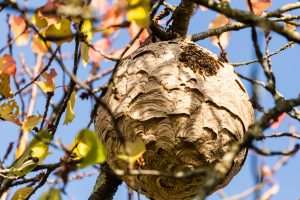
Vespa velutina secondary nest, with adult hornets huddled together warming up in the sun. Photo by YVO-Photos, Adobe Stock.
Remarkably, a single mated female has the potential to initiate a new colony. Primary nests, starting as small as a tennis ball, undergo significant expansion. Secondary nests, reaching heights of up to one meter and containing over 17,000 cells, are typically situated at altitudes of 60 to 70 feet, making them challenging to access. A single hornet nest has a voracious appetite, as it can consume up to 25 pounds of insect biomass in a single season, underscoring the ecological impact of yellow-legged hornet colonies.
As a predatory wasp, the yellow-legged hornet feeds on a variety of arthropods, displaying opportunistic behavior, including feeding on decaying animals. While the ecological impact is not fully understood, DNA in the gut of hornets shows that they feed on other wasps, bees, butterflies, moths, and spiders. However, honey bees, particularly Apis mellifera, are preferred targets, posing a significant threat to the beekeeping industry. Reports from Europe suggest that up to 30 percent of honey bee hives are weakened by attacks, with approximately five percent facing complete destruction.

A male Vespa velutina, which exhibits longer, thicker antennae compared to females and, in line with all Hymenoptera males, lacks a stinger. Photo by Gilles San Martin, licensed under CC BY-SA 2.0.
Initially attracted to the honey bee hive by hive pheromones, yellow-legged hornets position themselves away from hive entrances, waiting for returning foragers, resulting in a “carpeting” of workers at the entrance. This term refers to the clustering or accumulation of honey bee workers near the hive entrance as they attempt to defend against the invading hornets. This behavior unfortunately leads to decreased colony production.
In response to this discovery, the UF/IFAS Honey Bee Research and Extension Laboratory is collaborating with the Florida Department of Agriculture and Consumer Services (FDACS) to disseminate information and efficiently handle reports of hornet sightings.
It’s essential to note that there are many domestic species, native to the United States, that closely resemble the invasive hornet but do not pose a threat to honey bees; in fact, many of them are valuable pollinators. The USDA has a photo gallery of these lookalikes, which can be accessed by visiting www.aphis.usda.gov and searching for ‘yellow-legged hornet.’

Vigilance from the public is crucial in minimizing the potential impact of Vespa velutina on honey bee populations in Florida and beyond. Photo by Danel Solabarrieta, licensed under CC BY-SA 2.0.
While the yellow-legged hornet can easily be confused with other hornets that are not problematic to honey bees, residents who believe they have identified Vespa velutina are encouraged to call the FDACS hotline at 1-888-397-1517.
If a sample is collected or a clear photo of the suspected hornet is available, please email dpihelpline@fdacs.gov along with location information to facilitate monitoring efforts. Vigilance and cooperation from the public are crucial in minimizing the potential impact of the yellow-legged hornet on honey bee populations in Florida and beyond.
For more information about the yellow-legged hornet, refer to the Vespa velutina UF/IFAS Featured Creatures fact sheet.
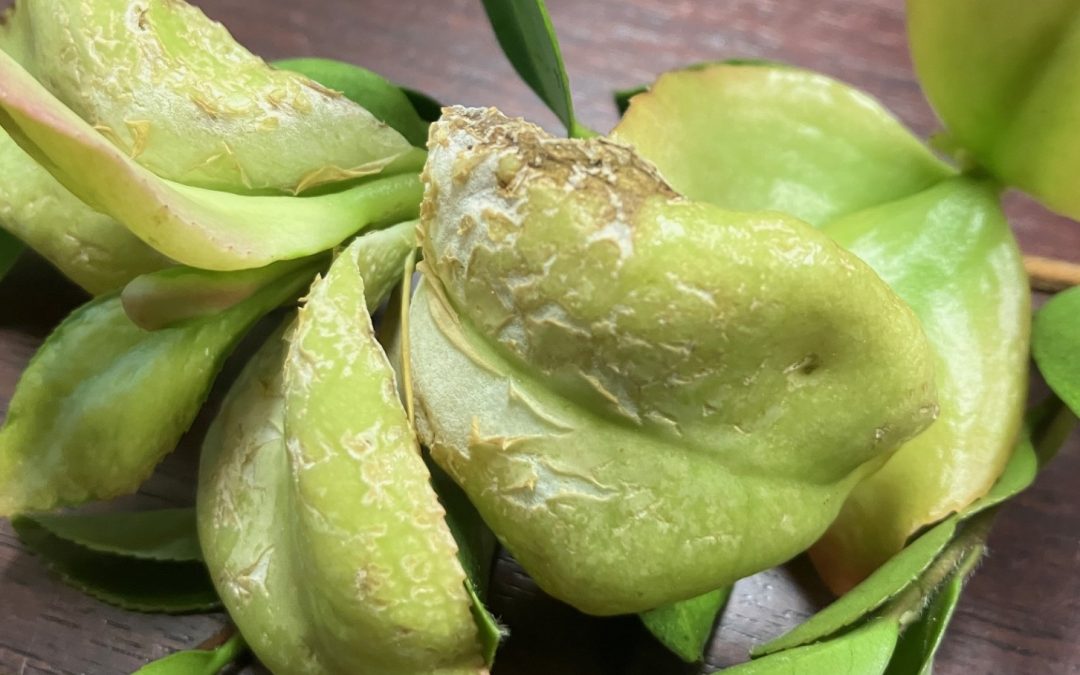
by Sheila Dunning | Apr 25, 2024
Extended spring weather with cool nights and frequent rain can be enjoyable for humans, but does strange things to plants, especially if dormant fungi are hanging around. Exobasidium vaccinii is a fungus that is believed to overwinter as spores attached to bark and bud scales. It can cause infection with the opening of buds in spring, creating odd shaped leaves and flowers that are referred to as galls. Infection is dependent on high humidity and moisture during bud break. Gall growth is due to plant cell division resulting from the stimulus of hyphal growth within host tissue. When galls are still soft, the fungus grows between epidermal cells, breaks the cuticle, and sporulates giving the gall a white cast. Either all or part of a leaf may become thickened, fleshy, and covered with a white bloom of spores. At first, diseased leaves are succulent and white, but they later shrink into hard, brown, gall-like bodies. Galls are composed of fungus-infected plant tissue. Older leaves are resistant to infection. Exobasidium vaccinii is most common in azaleas and camellias.

Photo by Sheila Dunning
But, other Exobasidium species are floating out there, and with just the right conditions they can deform other plants. That’s what caused this odd formation on one flower of a gardenia plant. In this case, the spores fused the sepals to the petals of the flower.
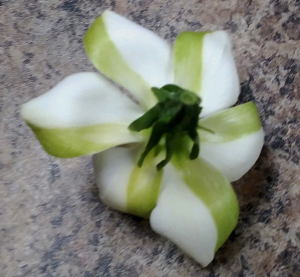
Photo by Margaret Stewart
While chemical controls are available, they would need to begin before symptoms appear and continue until the gall dried completely. It may be an option for the fastidious weather watcher with a good working knowledge of this disease. But, for the rest of the population, removing and destroying galls before they turn white is the best management practice to avoid having spores form and hang around until next spring. Proper pruning of the plants to improve air circulation will also reduce the chances of favorable conditions, should there be an extended cool, wet season next year.

















